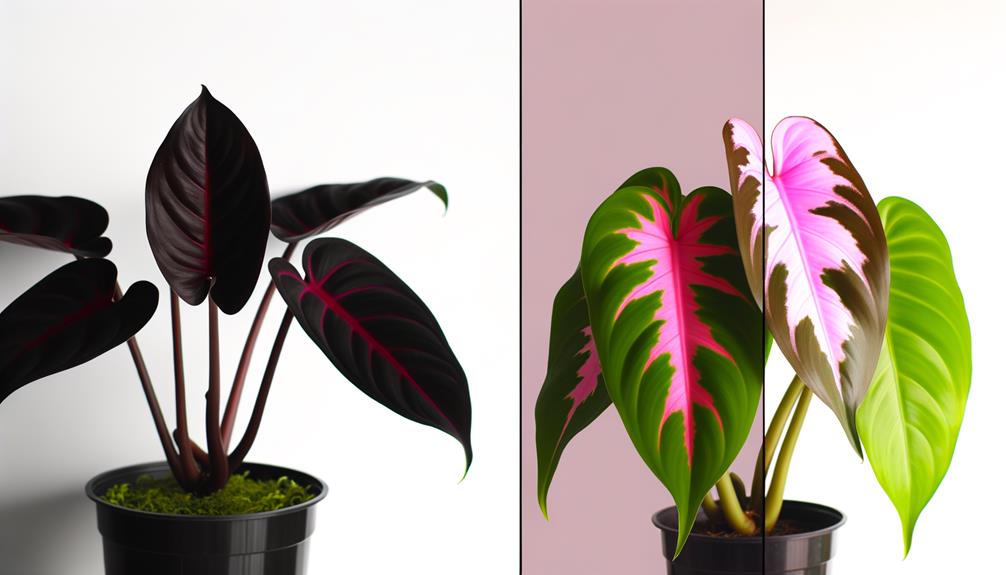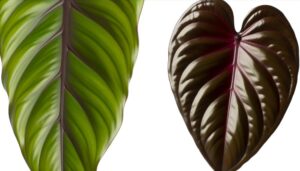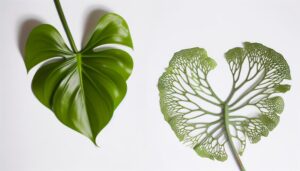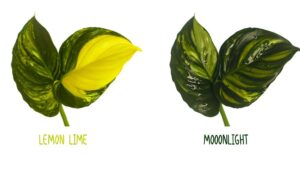Philodendron Black Cherry Vs Pink Princess: Which to Choose?
Philodendron Black Cherry and Philodendron Pink Princess, both from Central and South America, possess unique foliage highly appreciated by horticulturists. Black Cherry features dark, velvety leaves with deep burgundy hues, while Pink Princess exhibits variegation with pink and green patches.
Thriving in high humidity and indirect light, both require organic-rich, aroid-specific soil mixes. They are propagated through stem cuttings containing at least one node, benefiting from humidity to facilitate root initiation.
Their aesthetic appeal, rarity, and market demand elevate their status in the plant collecting community. For a more in-depth exploration of these stunning philodendrons, additional insights await.

Comparison of Philodendron Black Cherry and Pink Princess
| Characteristic | Philodendron Black Cherry | Philodendron Pink Princess |
|---|---|---|
| Leaf Color | Darker, almost black | Pink variegation on green leaves |
| Variegation | Pink variegation on very dark background | Pink variegation on green background |
| Rarity | Newer, less common variety | More established, widely known |
| Origin | Variation of Pink Princess | Original variegated cultivar |
| Price | Generally more expensive | Variable, but typically less expensive than Black Cherry |
| Care Requirements | Similar to Pink Princess | Moderate, requires bright indirect light |
| Popularity | Growing in popularity | Highly popular among collectors |
| Leaf Texture | Similar to Pink Princess | Glossy leaves |
Origin and Background
The Philodendron Black Cherry and Philodendron Pink Princess are both cultivars of the genus Philodendron, which is native to the tropical regions of Central and South America.
These cultivars have been selectively bred to accentuate their distinctive characteristics. Philodendrons thrive in the understories of tropical rainforests, where humidity and indirect light conditions are ideal for growth.
The cultivation of these unique varieties involves meticulous propagation practices, such as tissue culture and selective breeding, to ensure genetic stability and desirable phenotypic traits.
The Black Cherry and Pink Princess cultivars have gained popularity among horticulturists and plant enthusiasts due to their aesthetic appeal and adaptability as indoor ornamental plants.
Understanding their origin and background provides insights into their cultivation and care requirements.
Appearance and Foliage
Philodendron Black Cherry displays dark, velvety leaves with deep burgundy hues, while Philodendron Pink Princess features striking variegation with patches of pink and green on its foliage.
The Black Cherry’s leaves are typically heart-shaped and possess a rich, satin-like texture, which enhances its visual appeal.
In contrast, the Pink Princess displays a unique variegation pattern where chlorophyll-deficient pink sectors juxtapose against the typical green, creating a visually dynamic appearance.
The pigmentation in Pink Princess can vary notably between individual leaves, often influenced by light exposure and genetic factors.
Both plants belong to the Araceae family and exhibit the characteristic philodendron leaf structure, but their distinct coloration and textural differences make them highly sought after by plant enthusiasts and collectors.
Growth and Care Requirements
Successful nurturing of both Black Cherry and Pink Princess philodendrons hinges on understanding their specific light, water, and soil needs. These tropical plants flourish in indirect, bright light. Overexposure to direct sunlight can lead to leaf burn.
Consistent watering is vital; the soil should remain moist but not waterlogged. Aroid-specific soil mixes, rich in organic matter, guarantee optimal development. Monitoring humidity levels (ideally 60-80%) supports their tropical nature.
| Need | Black Cherry | Pink Princess |
|---|---|---|
| Light | Bright, indirect light | Bright, indirect light |
| Water | Moist, not waterlogged | Moist, not waterlogged |
| Soil | Aroid mix, organic | Aroid mix, organic |
Following these basic care principles ensures strong growth and lush foliage for both varieties.
Propagation Techniques
Understanding the propagation techniques for Black Cherry and Pink Princess philodendrons is vital to expanding your collection and ensuring genetic consistency. Both cultivars are typically propagated through stem cuttings, which involve excising a segment of the plant’s stem containing at least one node, the site of root and shoot development.
The cuttings should be placed in a well-draining medium, such as perlite or sphagnum moss, and kept in a humid environment to facilitate root initiation. Hormonal rooting agents can enhance success rates by stimulating cell differentiation.
It is essential to maintain ideal temperature and moisture levels during the propagation process to prevent fungal infections and promote healthy root growth. Regular monitoring and gradual acclimatization to ambient conditions are recommended.
Popularity and Market Value
The ever-increasing demand for unique foliage and rare plant varieties has greatly elevated the popularity and market value of both the Black Cherry and Pink Princess philodendrons. Enthusiasts and collectors are drawn to their striking variegation and vibrant hues, leading to heightened desirability.
This surge in interest can be attributed to several factors:
- Aesthetic Appeal: Both varieties exhibit visually stunning foliage, with the Black Cherry’s dark leaves and the Pink Princess’s pink variegation enchanting plant lovers.
- Limited Availability: Their scarcity in the market drives up prices, making them coveted specimens.
- Social Media Influence: Platforms like Instagram amplify their allure, showcasing these plants in curated settings.
- Investment Potential: Collectors view these philodendrons as valuable assets, often appreciating over time.
Conclusion
To sum up, the Philodendron Black Cherry and the Pink Princess, although belonging to the same genus, display remarkably distinct characteristics in leaf coloration, growth patterns, and market dynamics.
The Black Cherry’s dark, nearly enchanting leaves stand out sharply against the Pink Princess’s vibrant pink patterns.
Both require particular horticultural conditions for best growth, yet their methods of propagation stay mostly the same.
The market worth of these plants can escalate to astronomical levels, fueled by their exceptional visual allure and scarcity among enthusiasts.






